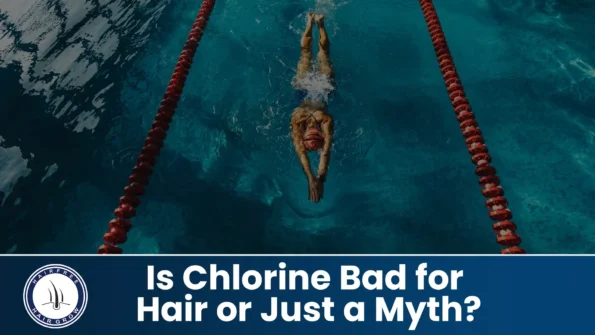Yes, chlorine can damage your hair—but with the right care, you can prevent or minimize its effects.
If you’ve ever left the pool with dry, brittle strands or noticed your hair color fading faster than expected, you’re not imagining things. Chlorine, a common disinfectant in swimming pools, can indeed have adverse effects on your hair. But is it always harmful, or are there ways to enjoy swimming without compromising your hair’s health? Let’s dive in.
Understanding Chlorine and Its Effects on Hair
Chlorine is used in pools to kill bacteria and keep the water safe. However, it’s a strong chemical that doesn’t discriminate between harmful microbes and the natural oils that protect your hair. When your hair is exposed to chlorinated water, several things can happen:
- Stripping of Natural Oils: Chlorine removes the sebum produced by your scalp, leading to dryness and brittleness.
- Color Fading: For those with dyed hair, chlorine can accelerate color fading and even cause discoloration.
- Increased Porosity: Chlorine can damage the hair cuticle, making hair more porous and prone to breakage.
- Scalp Irritation: Prolonged exposure can lead to an itchy, flaky scalp.
For hair transplant patients, these effects are amplified. Newly transplanted follicles are still anchoring into the scalp, and a dry, irritated scalp can stress these grafts. Chlorine’s effects on hair are real, especially for those with vulnerable scalps or new grafts.
Is Chlorine Always Harmful?
Not necessarily. Occasional exposure to chlorinated water is unlikely to cause significant damage, especially if you take preventive measures. However, regular swimmers or those with chemically treated hair should be more cautious. Hair types that are fine, porous, or color-treated are more susceptible to chlorine damage.
How to Protect Hair from Chlorine
Before Swimming
- Rinse Your Hair: Wet hair absorbs less chlorine. By saturating your hair with clean water, you reduce its capacity to soak up chlorinated water.
- Apply a Protective Barrier: Use a leave-in conditioner or natural oils like coconut or olive oil to create a barrier between your hair and the chlorine.
- Wear a Swim Cap: A well-fitting swim cap can significantly reduce chlorine exposure. While not entirely waterproof, it minimizes the amount of chlorinated water that comes into contact with your hair.
- Tie Up Your Hair: If a swim cap isn’t an option, tying your hair into a bun or braid can reduce the surface area exposed to chlorine.
After Swimming
- Rinse Immediately: As soon as you exit the pool, rinse your hair thoroughly with fresh water to remove any chlorine residue.
- Use a Clarifying Shampoo: Once a week, use a clarifying shampoo to remove chlorine buildup. Be cautious not to overuse it, as it can strip your hair of essential oils.
- Deep Condition: Apply a deep conditioning treatment to replenish moisture and repair any damage.
- Detangle Gently: Use a wide-tooth comb to detangle your hair, starting from the ends and working your way up to prevent breakage.
Special Considerations for Different Hair Types
- Color-Treated Hair: Use color-safe, sulfate-free shampoos and conditioners. Limit exposure to chlorinated water when possible.
- Natural and Curly Hair: Focus on moisture retention with regular deep conditioning. Protective hairstyles can also minimize exposure.
- Children’s Hair: Use gentle, tear-free products and ensure thorough rinsing before and after swimming.
Recommended Products for Chlorine Protection
- Fairy Tales Sun & Swim Lifeguard Clarifying Shampoo: Formulated with natural ingredients like grapefruit peel oil and pineapple fruit extract, this shampoo effectively removes chlorine while hydrating and conditioning hair.
- Dove Ultra Care Coconut & Hydration Shampoo and Conditioner: Infused with Nutritive Serum, these products lock in essential moisture without weighing hair down.
- Innersense Sweet Spirit Leave-In Conditioner: This leave-in conditioner forms a protective layer, keeping the cuticle closed and helping to eliminate the absorption of chlorinated water.
Conclusion
While chlorine is essential for keeping pools clean, it can have detrimental effects on your hair if proper precautions aren’t taken. By understanding how chlorine interacts with your hair and implementing protective measures, you can enjoy swimming without compromising your hair’s health. Remember, the key is prevention and proper aftercare.
Frequently Asked Questions (FAQs)
1. Does chlorine cause permanent hair damage?
No, but repeated exposure can weaken hair over time. Regular care prevents lasting harm.
2. How soon can I swim after a hair transplant?
Wait 4-6 weeks and consult your surgeon to ensure grafts are healed.
3. What’s the best shampoo for removing chlorine?
Clarifying shampoos like UltraSwim or Malibu C Swimmers Wellness are highly effective.
4. Can swim caps fully protect hair from chlorine?
They reduce exposure significantly but aren’t 100% waterproof. Combine with pre-swim protection.
5. How does chlorine affect colored or transplanted hair?
It can fade color and dry out hair, requiring extra conditioning and gentle care.
Written By
MD (Skin & VD)
Dr. Chintan Bhavsar is a trusted hair specialist known for his expertise in diet-related hair issues. He offers scientific insights on questions like Does Mango Cause Hair Loss, helping patients understand food-hair connections and maintain healthy, strong hair through evidence-based guidance.
Disclaimer
We’ve made all possible efforts to ensure that the information provided here is accurate, up-to-date and complete, however, it should not be treated as a substitute for professional medical advice, diagnosis or treatment. See Detailed Disclaimers Here.


